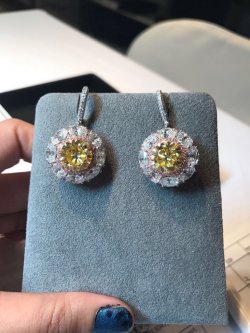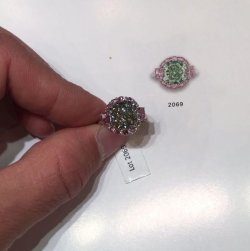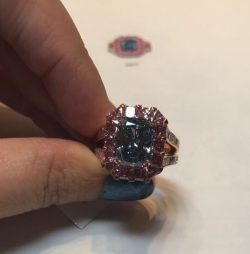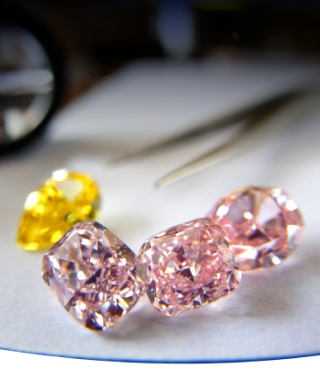Christie’s Hong Kong pre-auction analysis
This pre-auction analysis will focus on visual elements that are not expressed on the GIA report, as well as other general observations that won’t appear in the catalog, such as Undertone, Color Dispersion, and Inner-Grade (UDI). We use grades 1, 2, 3, and 4 to describe these features. . Stones with a total quality score that ranges from 8 to 12 are considered to be top gems and are suitable for high-end jewelry, collectables, and so on.
It is often difficult to identify these characteristics when viewing fancy color diamonds in an auction catalog or online, especially when the images are heavily processed. All images in this review were taken with an iPhone 7.
Important note: We strongly recommend downloading the beta version of the new FCRF app and using the auction calculator. This app lets you calculate your bidding price (per carat), including the house commission, as you follow the lot.
Lot No’ 1941
3.37 carat fancy intense blue hexagonal shape diamond, I1
High catalog estimation: US$237,400 per carat
Low color dispersion is inherent in very flat diamonds (with low depth percentage) and color manipulation is very challenging in shapes such as hexagon. Having said that, however, this rare blue diamond has a relatively decent color dispersion, considering these circumstances.
The inner-grade is above the average intense blue, and the undertone has a low gray influence. Inclusions in flat stones are usually visible to the naked eye and will have a strong impact on value. In this case, the feather is quite transparent and not very visible.
Inner-Grade: 3
Color Dispersion: 2
Undertone: 3
Total quality score: 8
Lot No’ 1947
5.10 carat fancy vivid yellow emerald shape diamond, VVS1
High catalog estimation: US$37,000 per carat
Vivid yellow Emerald cut diamonds always attract a higher level of attention. The inner-grade is above the average vivid yellow. In relative terms, the color dispersion in this case is considered average. According to the GIA plot on the report, one can assume the VVS1 grade can be removed and improve the stone’s clarity to IF (internal flawless). The depth percentage of the stone is 77%, which is considered high, making the stone look smaller than its actual size.
Inner–Grade: 3
Color Dispersion: 3
Undertone: 3
Total quality score: 9
FCRF Rarity grade: Exceptionally Rare (8th out 10 levels)
Lot No’ 1951
3.08 carat fancy vivid yellowish orange oval shape diamond
High catalog estimation: US$123,400 per carat
This stone receives a very high score in the three visible elements of inner-grade, dispersion, and undertone; however, the clarity grade is low, and the owner of the stone chose to ask for a GIA color-only report. When looking carefully, inclusions are visible to the naked eye.
Inner–Grade: 4
Color Dispersion: 3
Undertone: 4
Total quality score: 11
Lot No’ 2067
4.16 and 4.11 carat fancy vivid yellow round shape diamond pair, IF, VVS1
High catalog estimation: US$84,500 per carat
The two round diamonds were cut with a very high crown, a technique that enables concentration of most of the diamond’s color in the table area. This technique has two disadvantages: first, it creates a colorless crown and a low color dispersion, and second, it creates a high depth percentage (averaging 63%), which makes the stones look smaller. The dimensions are similar, but the inner-grade is a bit different, which damages the general look as a matching pair.
4.16 ct
Inner–Grade: 3
Color Dispersion: 2
Undertone: 2
Total quality score: 7
4.11 ct
Inner–Grade: 2
Color Dispersion: 2
Undertone: 2
Total quality score: 6
Lot No’ 2069
5.28 carat fancy intense green radian shape diamond, VS2
High catalog estimation: US$660,000 per carat
Visual analysis relates to the center stone only.
Initially, the stone was not cut as a radiant from the rough. Looking at the bottom facets of the stone (pavilion) and the colorless crown, it looks like it was recut from a lighter-color round brilliant in order to lengthen the light path and reinforce the color to its current one.
Inner-Grade: 2
Color Dispersion: 2
Undertone: 2
Total quality score: 6
Lot No’ 2074
4.64, 4.01 carat fancy purplish pink oval shape diamond pair, VS1, VVS2
High catalog estimation: US$440,000 per carat
It is very challenging to find two pink diamonds that will match in both weight and measurements, and even harder to match all three visual elements. The color dispersion in both stones is quite low and exhibits most of its color at the edges. The contrast between the colorless patches and the colored areas is prominent, which creates the optical illusion that the inner-grade is strong. The two stones have a cold pink undertone, stronger in one more than the other, and receive a high grade under this section.
4.64 ct
Inner-Grade: 3
Color Dispersion: 2
Undertone: 3
Total quality score: 8
4.01 ct
Inner-Grade: 3
Color Dispersion: 2
Undertone: 4
Total Quality score: 9
Lot No’ 2077
3.98 carat fancy vivid blue radian shape diamond, VVS2
High catalog estimation: US$2,763,820 per carat
From the old fashioned-style cut of this rare blue diamond, it looks like the stone was polished before the 1990s. This stone is cut like a typical colorless radiant, and this is the reason the color dispersion is low, with many colorless patches on the table view. The undertone of the blue color is quite high, as it has a low gray influence. Its inner-grade is above the average.
Inner–Grade: 3
Color Dispersion: 2
Undertone: 3
Total quality score: 8
FCRF Rarity grade: One Of A Kind (9th out 10 levels)





